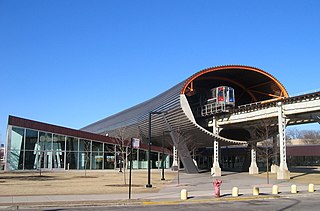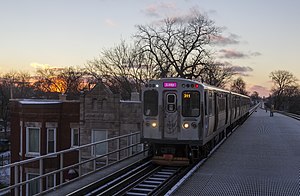
The Chicago Transit Authority (CTA) is the operator of mass transit in Chicago, Illinois and some of its surrounding suburbs, including the trains of the Chicago "L" and CTA bus service.

The Red Line, sometimes known as the Howard-Dan Ryan Line or the North-South Line, is a rapid transit line in Chicago, run by the Chicago Transit Authority (CTA) as part of the Chicago "L" system. It is the busiest line on the "L" system, with an average of 251,813 passengers boarding each weekday in 2012. The route is 23.4 miles (37.7 km) long with a total of 33 stations, from Howard station in Rogers Park on the north side, through the State Street subway and to 95th/Dan Ryan in Roseland on the south side. Like the Blue Line, the Red Line runs 24 hours a day, 365 days a year; the CTA is one of only five rapid transit systems in the United States to do so. A proposed extension adding four new stations would extend the Red Line south from 95th/Dan Ryan to 130th Street.

The Orange Line is a rapid transit line in Chicago, Illinois run by the Chicago Transit Authority as part of the "L" system. It is approx. 12.5 miles (20.1 km) long and runs at grade and serves the Southwest Side, running from the Loop to Midway International Airport. In September 2012, the average weekday boardings on the Orange Line were 63,037.

The Blue Line, also known as the O'Hare-Congress Line and the West-Northwest Line, is a 26.93-mile-long (43.34 km) Chicago "L" line which extends through the Loop from O'Hare International Airport at the far northwest end of the city, through downtown via the Milwaukee-Dearborn Subway and across the West Side to its southwest end at Forest Park, with a total of 33 stations It is the CTA's second busiest rail line, with an average of 186,796 passengers boarding each weekday in September 2012.

The Brown Line of the Chicago "L" system, is an 11.4-mile (18.3 km) route with 27 stations between Chicago's Albany Park neighborhood and downtown Chicago. It runs completely above ground and is almost entirely grade-separated. It is the third-busiest 'L' route, with an average of 63,481 passengers boarding each weekday in 2017.

The Purple Line of the Chicago Transit Authority is a 3.9-mile (6.3 km) route on the northernmost section of the Chicago "L" rapid transit system. Normally, it extends south from Linden Avenue in Wilmette, passing through Evanston to Howard Street, on Chicago's north side. In 2016, the average weekday boardings on the Purple Line was 10,187.
The rolling stock of the Washington Metro system consists of 1,242 75-foot (23 m) cars that were acquired across seven orders. All cars operate as married pairs, with systems shared across the pair. The 7000-series cars, the system's newest, have an operator's cab in only one of each married pair's cars and typically operate in groups of four.

Harold Washington Library-State/Van Buren is an 'L' station serving the CTA's Brown, Orange, Pink, and Purple Lines. Originally, the station was to have direct access to the second floor of the Harold Washington Library building, but this direct connection was never built. Farecard transfers are also available at the station for the Blue and Red Lines via the Jackson/Dearborn and Jackson/State subway stations, respectively. It was originally known as State/Van Buren when it first opened in 1897. The original station closed on September 2, 1973, along with six other stations, due to low ridership, and demolished in 1975. The new station was rebuilt and reopened on June 22, 1997 in order to serve the Harold Washington Library. The Chicago Transit Authority board voted unanimously on Wednesday, October 6, 2010, to rename the station to its current name.
The current rolling stock of the Chicago "L" rapid transit system consists of three series of railcars. The oldest series is the 2600 series which was built between 1981 and 1987 and refurbished between 1999 and 2002. The second series is the 3200 series, built between 1992 and 1994 and refurbished between 2015 and 2018. The third and newest series is known as the 5000 series; built between 2009 and 2015, they feature new technologies such as LED color signs, security cameras, new seating configuration, AC motors, and date and time.

Morgan/Lake is a station on the Chicago Transit Authority's Green and Pink Lines in the Near West Side neighborhood of Chicago, Illinois. The original station on this site was closed and demolished in early 1949; after years of intense lobbying by local residents and members of the Fulton Market Merchant Association, the Chicago Department of Transportation rebuilt the station from 2010–2012. The new station opened on May 18, 2012.

The 2200 series was a series of Chicago "L" cars built in 1969 and 1970 by the Budd Company of Philadelphia, Pennsylvania. 150 cars were built. The last 8 2200-series cars were retired from service after their ceremonial last trips on the Blue Line on August 8, 2013. These cars were in service for 44 years. All cars except the preserved ones were scrapped by October 2015.

The 2400 series is a series of Chicago "L" cars built between 1976 and 1978 by Boeing-Vertol of Ridley Park, Pennsylvania, with shells fabricated by Sorefame. 200 cars were built and on October 31, 2014, the series was retired from revenue service. These cars were in service for 38 years.

The South Side Elevated is a branch in Chicago, run by the Chicago Transit Authority (CTA) as part of the Chicago "L" system. It is an active branch that is served by the Green Line, with the Roosevelt station, that is also served by the Orange Line. It has on average 12,509 passengers, counting branch divisions, boarding each weekday as of February 2013, according to the CTA. The branch is 6.5 miles (10.5 km) long with a total of 8 stations, and runs from the Near South Side to the Washington Park neighborhood of Chicago. The branch runs from 3:50 a.m. to 1:05 a.m. on weekdays, 4:50 a.m. to 1:05 a.m. on Saturdays and 4:50 a.m. to 1:05 a.m. on Sundays/Holidays.

The 7000 series is an upcoming series of rail car for the Chicago "L". The base order is for 400 cars and will be used to replace the 2600-series cars, dating back to the 1980s, which are currently assigned to the Blue, Brown, and Orange Lines. If the Chicago Transit Authority (CTA) orders the additional 446 cars, these cars would replace the 3200-series cars, dating back to the early 1990s, which are currently assigned to the Blue and Brown Lines. Including all options, which is a total of 846 cars, the order will cost $1.3 billion. The contract requires ten prototypes to be delivered by October 2019. If the rail cars prove to be acceptable, then full production cars would be delivered starting in October 2020, at a rate of 10 cars per month. The cost per car is approximately $1.58 million.

















